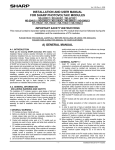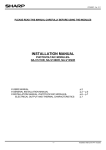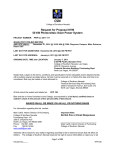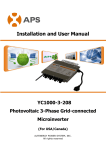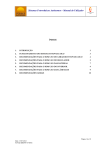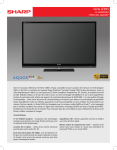Download SHARP SOLAR
Transcript
SHARP SOLAR Frequently Asked Questions for PV Integrators Revised 05/04/2010 How do I determine the PTC rating of a module? PTC refers to PVUSA Test Conditions, which were developed to test and compare PV systems as part of the PVUSA (Photovoltaics for Utility Scale Applications) project. PTC are 1,000 Watts per square meter solar irradiance, 20° C air temperature, and wind speed of 1 meter per second at 10 meters above ground level. PV manufacturers use Standard Test Conditions (STC) to rate their PV products. STC are 1,000 Watts per square meter solar irradiance, 25° C cell temperature, air mass equal to 1.5, and ASTM G173-03 standard spectrum. The PTC rating, which is lower than the STC rating, is generally recognized as a more realistic measure of PV output because the test conditions better reflect "real-world" solar and climatic conditions, compared to the STC rating. PTC ratings are DC (direct current) watts. Module operating temperature increases relative to air temperature when placed in the sun. As the operating temperature increases, the power output decreases (due to the properties of the conversion material - this is true for all solar modules). PTC ratings take this into consideration to a limited degree by calculating the PTC ratings based in part on the specific module characteristic for output vs. temperature (the temperature coefficients). The PTC ratings are different for each module, and typically vary from approximately 87%-92% of the STC rating. A typical decrease in power output is approximately 12% for crystalline-based solar modules. This decrease results in an STC rated 170 Watt DC crystalline solar module being PTC rated at approximately 149 Watts DC. Sharp thin film solar modules, on the other hand, experience only half the rate of power loss due to temperature rise when compared to typical crystalline-based solar modules. This means that the typical PTC rating for Sharp thin film modules is approximately 6% less than the STC rating. This decrease results in an STC rated 121 Watt DC thin film solar module being PTC rated at approximately 114 Watts DC. Go Solar California keeps a current list of PTC ratings for many modules. See http://www.gosolarcalifornia.org/equipment/pvmodule.html. How do I determine a module’s efficiency? Module efficiency is calculated using the following equation: Module efficiency (%) = Module nameplate power rating (W) / [Total module surface area (m²) x 1000 W/m²] The module’s efficiency can be found on the reverse side of the module’s spec sheet which can be downloaded at the following website: http://www.sharpusa.com/SolarElectricity/SolarProducts/LiteratureDownloads.aspx How do I determine the power that I’ll get from a module (or a system)? Solar irradiance is the instantaneous intensity of the sun’s power measured with respect to area. Solar irradiance is commonly expressed in units of watts per square meter (W/m²). Insolation is the total amount of solar energy that reaches the Earth’s surface over time. Insolation is commonly expressed as kWh/m²/day or equivalent peak sun hours. Every location on earth has a different amount of sunlight exposure throughout the year. For example, a northern U.S. city like Boston, MA will have a lower annual average insolation than a desert city like Phoenix, AZ because of climatic differences such as precipitation, fog, humidity and sky condition and distance from the equator. Since solar modules produce power, and resulting energy, when exposed to sunlight, the more insolation a location receives, the more energy will be produced from a module installed at that location. Recorded insolation data for particular locations is used to help approximate the energy produced by a module, as it is the energy from the sun that is converted to energy from the solar module. The amount of insolation for one particular location differs from day to day. There are multiple insolation data sources that slightly differ from one another. The U.S. Department of Energy and NASA have recorded this data for over 30 years and have calculated insolation data for many locations, which helps predict approximate yearly energy output for that location. One list of insolation data can be downloaded for specific locations here: http://rredc.nrel.gov/solar/pubs/redbook/. In addition to the data sets described above, color-coded solar resource maps can also show how insolation varies for different regions of the country. The National Renewable Energy Laboratory (NREL) provides U.S. solar resource maps here: http://www.nrel.gov/gis/solar.html. Software programs assist with the calculation of estimated average monthly or yearly photovoltaic system output. See: PV-DesignPro: http://www.mauisolarsoftware.com PVsyst: http://www.pvsyst.com PV Watts v.1: http://rredc.nrel.gov/solar/codes_algs/PVWATTS/version1/ Solar Advisor Model (SAM): https://www.nrel.gov/analysis/sam/ PV manufacturers use Standard Test Conditions, or STC, to measure their PV products. STC are 1,000 Watts per square meter solar irradiance, 25° C cell temperature, air mass equal to 1.5, and ASTM G173-03 standard spectrum. These standardized conditions are used as a baseline reference for measuring the electrical characteristics of a photovoltaic module. Instantaneous power output is relative to the intensity of the light (irradiance) that reaches the solar cells as well as the instantaneous cell temperature. Instantaneous cell temperature is typically 20-30°C higher than ambient temperature when the instantaneous irradiance is 1000 W/m². The equation for calculating power is as follows: Power (W) = Voltage (V) x Current (A). The DC current from a module is relative to irradiance. As the irradiance increases, so does the DC current though other factors also have an impact on current. The voltage output from a module is affected by cell temperature. As temperature increases, the voltage output decreases. For example, the Sharp NU-U235F1 module has a VOC temperature coefficient of -0.351%/°C. This means that for every degree Celsius rise over the STC reference of 25°C, the open circuit voltage will decrease 0.351% from the Voc tested at STC. Similar to voltage, the power output from a module is also affected by cell temperature. For example, the Sharp NU-U230F3 module has a maximum power temperature coefficient of -0.485%/°C. This means that for every degree Celsius of temperature rise over the STC reference of 25°C, the maximum power output will decrease 0.485% from the maximum power tested at STC. How should I clean my module(s)? Sharp PV modules are designed for long life and require very little maintenance. If the angle of the PV module is 5 degrees or more, normal rainfall is usually sufficient to keep the module glass surface clean under most weather conditions. If dirt build-up becomes excessive, clean the glass surface only with a soft cloth using water. If cleaning the back of the module is required, take utmost care not to damage the back side materials. In order to ensure proper operation of the system, please check all wiring connections and the condition of the wire insulation periodically. Sharp solar modules should be rinsed with clean, potable water early in the morning or in the late afternoon. Spraying the array mid-day should be avoided so as not to thermally shock the module glass. WARNING: Please be aware that there is a serious risk of various types of injury occurring when working around high voltage solar equipment including the risk of electric shock. Never spay water on any wires; all spay should impinge on the front of the modules only. Do this only at your own risk. The risk of injury is greatly increased when working on a roof. Never attempt to work on a rooftop unless you have appropriate OSHA approved safety precautions in place, including fall protection, ladders or stairways, and personal protective equipment. How do I file a warranty claim? Warranty service is available at a Sharp Authorized Dealer located in the United States. Call toll free at 1-800-765-2706 to find the location of the nearest Sharp Authorized Dealer or to obtain a Return Authorization Number and shipping instructions. Proof of Purchase will be required. Ship prepaid or carry in your Product to a Sharp Authorized Dealer. Be sure to have Proof of Purchase available. If you ship the Product, be sure it is insured and packaged securely. Sharp will not be responsible for the costs of de-installation or reinstallation. What do the codes mean on my Sharp SunVista Inverter? Sharp customers have access to the service manual for the Sharp’s SunVista inverter which contains information about error codes at http://www.sharponline.com How do I mount modules? Modules should be mounted in accordance with the Sharp installation manual that is specific to the module model. Modules which do not require the OnEnergy mounting system may be mounted using either the bolt hole on the frame of the module or with a top clamping method (see installation manual). Please note that if using a top clamping method, one must clamp on the long edge of the module in the appropriate location. How do I dispose of modules at the end of life? Sharp recommends that whenever possible, one should recycle the aluminum frame on the module. The frame can be detached by removing the screws on the corners of the frame. The remaining material should be disposed of in accordance with your local regulations. CAUTION: The module’s lead cables may be “hot” and carrying current, especially if the module is exposed to light. Please exercise extreme caution to avoid the risk of electric shock. In addition, exercise caution when removing the module’s frame as the glass may be broken. Removing the frame may expose you to sharp metallic or glass edges. What degradation should I expect? Overtime, modules will yield less output for a given set of weather conditions. This is often referred to as degradation and is typically considered on an annual basis. The rate of degradation is affected by module construction technology, cell technology and weather. Degradation of 0.5% per year is not atypical for crystalline modules. Sharp’s standard warranty addresses degradation for both the first 10 years and following 15 years for a total of 25 years (from date of sale). Can I repair a module? Can I replace the output cables? Sharp PV modules are not user serviceable and replacement parts are not available. The dealer or installer should be contacted for possible warranty consideration. Can I get CAD files for the modules? CAD files are not available. If you need drawings other than what is available on the Data Sheets, please contact Sharp. Are Sharp’s modules tested for damage due to hail impact? Sharp does not test for damage due to hail impact. Sharp’s modules for sale in the USA are UL listed (listed to UL 1703). As part of the listing process, the modules are subjected to a series of tests performed by a Nationally Recognized Testing Laboratory. One of these tests, the impact test, involves dropping a 2” diameter steel ball weighing 1.18 lbs from a height of 51 inches onto the glass surface of the module and seeing if there is sufficient damage to create a safety hazard. Some Sharp modules are IEC 61646 certified. The IEC testing protocol includes a test in which balls of ice are shot at the module. IEC certified Sharp modules are tested with 25 mm ice balls weighing 7.53 g fired at 23 m/s. Sharp does not warrant the module against breakage from impact. What wind speed can the modules withstand? Sharp’s crystalline modules are approved for a maximum load of 2,400 PA (50 psf). Sharp’s UL listed H1 series thin film modules are approved for a maximum load of 1,600 PA (33 psf) whereas Sharp’s H5 series IEC certified thin film modules are approved for 2,400 PA. The process of translating the module maximum load rating into a maximum wind speed rating is site specific and involves multiple variables such as the location’s basic wind speed, exposure category, installation height above ground, etc. In general, a specialist engineer is needed to convert wind speed into an accurate mechanical load for a specific installation. To determine your local wind speed requirements, please contact your local authority having jurisdiction. The American Society of Civil Engineers (ASCE) Standard 7-05 provides a detailed explanation of how to calculate the minimum design wind load for buildings and other structures. Where do I find an installation manual? Sharp’s customers can access installation manuals here: http://www.sharponline.com Where is training offered? Sharp’s 2-day residential solar installation training program is offered in Huntington Beach, CA and Mahwah, NJ. More information on Sharp solar training, please visit: http://www.sharpusa.com/SolarElectricity/BecomeAnInstaller/Training.aspx What certifications or standards do SHARP modules comply with? Sharp’s modules for sale in the USA and Canada are either listed to Underwriters Laboratories (UL) Standard 1703 for flat plate PV modules or the International Electrotechnical Commission (IEC) Standard 61646 for thin-film terrestrial PV modules. UL 1703 is a safety standard for flat-plate photovoltaic modules. The following website lists the tests conducted for UL 1703 certification: http://www.ul.com/global/eng/pages/offerings/industries/energy/renewable/photovoltaics/ tests/ Sharp’s H5 series thin film modules are tested according to IEC Standard 61646, Thinfilm Terrestrial Photovoltaic (PV) Modules‐ Design Qualification and Type Approval. Additional U.S. specific certifications and approvals include the California Solar Initiative (CSI), the Florida Solar Energy Center (FSEC), and the Puerto Rico Energy Affairs Administration (EAA). A complete list of Sharp modules conforming to these additional certifications can be found on the agencies’ respective websites: CSI: http://www.gosolarcalifornia.org/equipment/pvmodule.html FSEC: http://www.fsec.ucf.edu/en/industry/testing/PVmodules/pv_flashtest_list.htm EAA: http://www.pr.gov/AAE/Fotovoltaicas/Lista+de+Módulos+Fotovoltaico.htm What are bypass diodes? What is their purpose? A bypass diode is used to pass current around, rather than through, a group of photovoltaic cells under certain conditions (current “bypasses” the group of cells). Bypass diodes are connected in parallel with groups of solar cells to mitigate the effects of a reverse bias condition within the module. Reverse bias is the condition of a device operating at negative (reverse) voltage. A module with cells in reverse bias will continue to pass current, but since the voltage is negative, the module will dissipate power through the cells that are in reverse bias, thereby reducing the amount of output power from the module. Power that is dissipated through the reverse bias cells can cause the cells to heat up. If this condition were to continue, there could be permanent damage to the module. Bypass diodes offer the alternative by allowing current to bypass groups of cells when cells in the circuit are in reverse bias; thereby eliminating the heat buildup and in essence, protecting the module. Bypass diodes allow the rest of the series-connected cells in the source circuit to continue to deliver power, but the source circuit will operate at a lower voltage. When the reverse bias condition stops, the diode no longer allows a bypass for current and the full output of the module is restored. The bypass diodes are located in the module’s junction box and are not user serviceable. 36-cell Sharp modules incorporate 2 internal bypass diodes, each connected to a group of 18 series-connected cells. 60-cell Sharp modules have 3 internal bypass diodes, each connected to a group of 20 series connected cells. 72-cell Sharp modules have 3 internal bypass diodes, each connected to a group of 24 series-connected cells. Sharp thin film modules have 4 internal bypass diodes, each connected to a group of 270 cells (45 cells in series by 6 in parallel). Are Sharp modules compliant with the “Buy American” clause of the ARRA stimulus bill? Yes. Currently, all of Sharp’s modules for sales in the USA fully comply with the “Buy American” clause of the ARRA stimulus bill. For more information, please see: http://www.sharpusa.com/SolarElectricity/SolarProducts/~/media/Files/Solar/sol_dow_A RRA.ashx Are Sharp modules compatible with microinverters? Many of Sharp’s modules are compatible with microinverters. Please contact the microinverter manufacturer directly for specifications for the microinverter; compare the module’s output specifications and the inverter input specifications, adjusting for the environmental conditions expected at the site to determine compatibility. Sharp does not endorse or approve any specific microinverter products.










